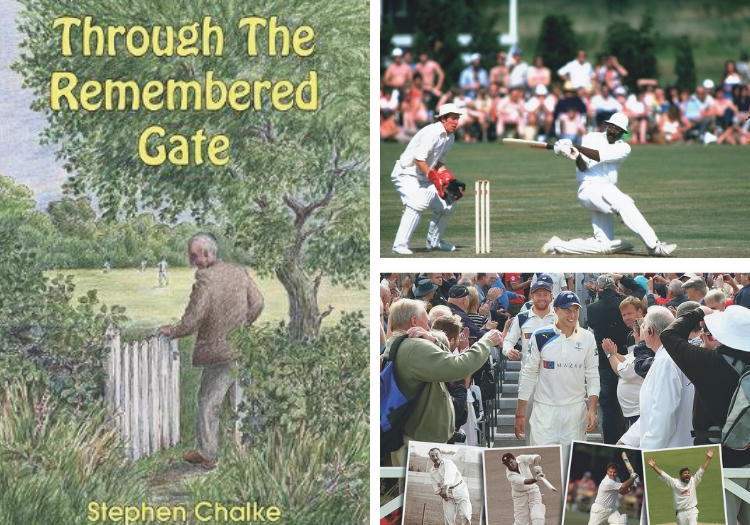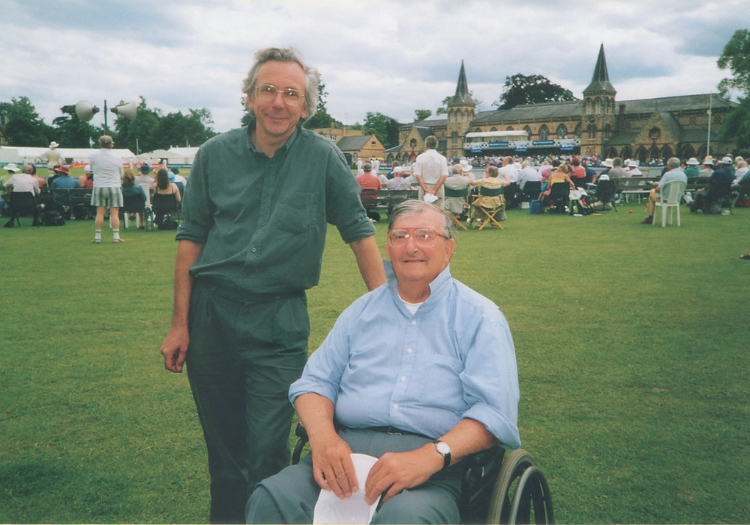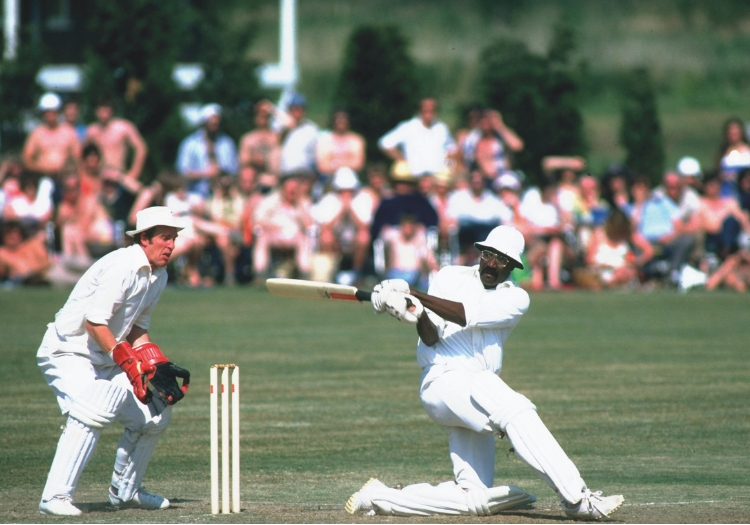STEPHEN CHALKE has published 42 books, of which he has written 19, in 23 years, capturing the memories of Tom Cartwright, Micky Stewart and many others. As he calls it a day, he looks back upon many fascinating encounters

It was never my intention to become a cricket writer, let alone a publisher.
Playing my last match of 1993, near Brentwood in Essex, I was out first ball – a ghastly shot that is still vivid in my memory – and I drove home to Bath in a state of weary despair. I was 45 years old; I’d had a poor season and was struggling with a bad back. In the car I resolved to give up playing.
But give up the friendships and the fun? When the pain of my abject failure eased, I realised I was not ready for that. So I took the advice I gave my students in adult education – “You’re never too old to learn” – and I went in search of some coaching. That, strange to tell, is how I became a cricket writer.
Every Friday afternoon for four winters I attended a two-hour net in Stroud, run by former Somerset bowler Ken Biddulph. And every week, long after the others had gone, I stayed to listen to Ken telling his stories of county cricket in the 1950s and early 1960s. They were the years when I had fallen in love with the game, and he brought alive with a humorous glow the characters of all the players, their strengths and their foibles. Not only that but their way of life: the late-night journeys between games, the struggle to find winter work, the absurdities of the amateur/professional divide. I was enchanted; it was as if I was back in my childhood, seeing it all with fresh eyes. Sometimes his stories would hold me there for an hour and a half.
For years I had been working on a book of autobiographical short stories, and it was driving Sue, my partner, batty. She knew nothing would ever come of it and, deep down, I did, too. Then in the autumn of 1996 I came up with the idea of writing a short story based on Ken’s most memorable match. He chose a game at Bath in 1959 when Somerset beat Yorkshire, a thrilling victory that was their first over the northerners since 1903, a game in which Brian Close featured prominently. “Funny man, Closey,” Ken said. “He could be both a brilliant genius and thick at the same time.” It’s still the best one-line summary of Close that I have heard.
I wrote up the story of the game, weaving in Ken’s observations, quotes from the reports in The Times and little titbits of contemporary news. When I read it to Sue, she looked unusually impressed. “I think you might be onto something with that,” she said.
I repeated the formula by driving all over England, interviewing county cricketers of the 1950s. My first port of call after Ken was Martin Horton in Worcester, who also chose a victory over Yorkshire. Then came Arthur Milton in Bristol, and he was going to do the same. I sat on his sofa, thinking “Shall I call this book The Day We Beat Yorkshire?” It seemed to be every cricketer’s favourite memory. But I thought no, and I asked him to choose another game.

Chalke with Bomber Wells at Cheltenham College
Another decision came when I went to hear Trevor Bailey speak. I had a letter in my pocket, asking if he would choose an Essex match for me. But, as I listened to him, I thought: ‘I’ve heard most of this before. I should be looking for the unheard voices.’
Like all new authors I was certain I would find a publisher, but the rejection letters mounted up. They were complimentary about the writing, but none thought the book commercially viable. County cricket in the 1950s, with no household names... it was too specialised. So, after taking advice, I published it myself as Runs in the Memory, and I was lucky. Very lucky.
Generally, in the papers, the sports pages don’t do books, and the book pages don’t do sport. But Frank Keating latched onto it, naming it as his Sports Book of the Year in The Guardian. Then came Michael Parkinson in the Daily Telegraph. Word of mouth spread, and I was taking orders galore, many from people who are still buying our books 20 years on. “We would need to sell at least 2,000 to make it viable,” one publisher had told me, and I finished up – after three reprints and a paperback edition – selling 4,500. Publishing seemed easy!
I thought hard about my second book. Part of me wanted to stay in the 1950s and write about repertory theatre, another of my childhood passions. But I played safe, aware of the contacts I had established, and wrote a sequel on county cricket in the 1960s.
Then came ‘Bomber’ Wells, one of the funniest men ever to play cricket. I had interviewed him for Runs in the Memory, which he loved, and he asked me to publish a novel he had written, an 800-page Dick Francis-style thriller set in the world of 1950s cricket. The plot was fantastical; the idea of trying to sell it scared me stiff.
“Why don’t you do a book of stories about your own playing days?” I suggested, and straightaway he came back: “Right, we’ll do that then.” So, without ever quite agreeing to it, I found myself writing a book with Bomber.
He was like a great Catherine wheel, talking non-stop and sending off sparks in every direction. It took me almost a year of weekly sessions to find a way of turning it into a coherent book. But I got there, and Frank Keating loved it. “It is as precise and formulated as a Pinter reunion on the stage,” he wrote. “Romantic, dangerous, even subversive.”
"I don’t know how you do it, but you always get me remembering so much"
While promoting the book at Cheltenham I ran into David Foot, whose writing on West Country cricket I found spell-binding. He was finishing a book of essays and was looking for a publisher. “I’ll do that,” I said without a moment’s thought, and suddenly I had moved on from self-publishing. I could not have had a better first author for such a step. David was a pleasure to work with, our only argument coming when I told him how much I proposed to pay him. “You can’t pay me that much,” he protested. “No, you won’t. I won’t accept it.”
The people at Surrey were looking for somebody to capture the memories of their 92-year-old former secretary Geoffrey Howard, and Scyld Berry recommended me. The idea was for me to do some tape recordings, but I was so taken by Geoffrey, his old-world charm and his Fabian politics, that I turned it into a book, centring it on the triumphant tour of Australia in 1954/55 that he managed.
A book about a long-forgotten administrator? “I can’t see anybody much buying that,” a friend said, but he was wrong. Unlike Bomber, Geoffrey did not talk 19 to the dozen – often I had to work hard to tease the memories out of him – but he produced some real gems that threw a sharp and not always comforting light on the past. One came when I asked him what briefing he had had from MCC before setting off as manager of a six-month tour of India. “Briefing?” he repeated. After a long silence, he recalled what the MCC secretary had said to him, leaning into his railway carriage as the train was about to leave: “Well, good luck, old boy, rather you than me. I can’t stand educated Indians.”
It won the Cricket Society Book of the Year award, and it sold out a print run of 2,000. Small beer for a bigger publisher but – with just Sue and me working from home, with an income from part-time lecturing and with a good mailing list buying direct from us – it was a viable project. That remained our model: publishing good books that are one layer down from the titles taken on by the mainstream publishers. Foot fitted into that perfectly, as did John Barclay, whose memoir of his first summer as Sussex captain we published. So much fun did John make that experience, and so captivated was I by the elegant simplicity of his prose, that we went on to publish a further two books by him.
Soon enough we were taking on other books: Anthony Gibson’s collection of his father Alan’s writing, Mark Wagh’s diary of a season, Simon Lister’s biography of Clive Lloyd, Pat Murphy’s celebration of Warwickshire’s annus mirabilis in 1994. So many good cricket books, all looking for a caring publisher.
Now, after 23 years, we are calling it a day. The boxes seem to be getting heavier when I hump them up two flights of stairs, the bookshops more resistant to our approaches, the cricketers of my early years now disappearing over the horizon.

Clive Lloyd, hitting out against Northamptonshire at Bletchley in 1980, was the subject of a biography by Simon Lister
We have published 42 books, of which I have written 19. It has been an extraordinary journey – not only in navigating our way through the world of bookselling but in understanding better, through the memories of the old cricketers, the world in which I grew up.
“I don’t know how you do it,” Ken Biddulph said to me one day, “but you always get me remembering so much.” It was not a remark I dwelt on at the time, but I have come to realise that, when the chemistry works, I do have a certain gift for that. At the front of my book with Howard I printed a quote by Alan Bennett: “Anyone of any distinction should, on reaching a certain age, be taken away for a weekend at the state’s expense, formally interviewed and stripped of all their recollections.”
That is what, in this little world of English cricket, my own books have been doing – with men whose testimony might otherwise have been lost: Tom Cartwright, whose coaching did so much to make Ian Botham the bowler he was; Micky Stewart, whose grasp of the post-war English game at all its levels is deeper than that of any man alive; Bob Appleyard, whose personal story, long bottled up and gently drawn out of him, is one of the most remarkable in the history of cricket; and Ken Taylor, the most modest of men who, with no sense of the extraordinariness of his life, rose from working-class roots in Huddersfield to play cricket for Yorkshire and England, football in the old First Division and at the same time to study art at The Slade.
Tom Cartwright was a man right up my street. A deep thinker, about cricket and about life, he had so much to say, and he said it with passion and with a turn of phrase that was almost poetic at times. A Labour man in a Conservative world, he had a way of saying his piece without making the argument personal. Cricket, he thought, had been taken over by men of money; they were not protecting what was special about the game.
Tragically, just before the book’s launch, he had a massive heart attack from which he died six weeks later. I was asked to deliver the tribute at his funeral, the saddest task in the life of Fairfield Books, and I ended it by reading three passages of Tom speaking: about the beauty of the game, about the pernicious acceptance of sledging, and how cricket can be a force for good in the world, bringing people of different backgrounds together on equal terms.
When I stepped down from the lectern, the whole congregation – moved by the glow of Tom’s words – burst into applause. Amid my grief, I felt an inner gladness that I had preserved those words. Books do matter.
This article was published in the April 2017 edition of The Cricketer - the home of the best cricket analysis and commentary, covering the international, county, women's and amateur game
Save 30% when you subscribe to The Cricketer’s print & digital bundle. £35 for 12 issues